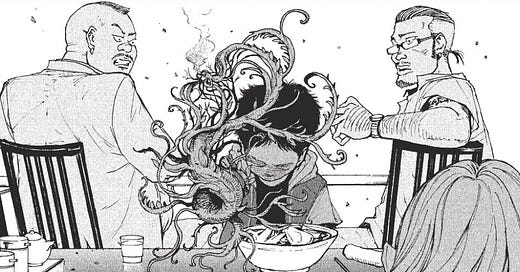I love it when a series sneaks up on me. When there isn’t so much hype, so I don’t really have any expectations. That’s happening with A-DO, a Stranger Things-esque story about a boy with spectacular powers who comes out of a secret government program where they’re trying to engineer people with special powers.
At least I think, I’m not that deep into it yet.
It can be challenging to introduce how powerful a character is when you first meet them. Usually it takes time. Off the top of my head, I remember Gojo’s laser-beam attack that literally cuts a cylindrical hole through everything in front of him. That was a flex that really showcased just how powerful he is, and it happened so quickly.
A-DO has a similar flex with Eito, a young boy with incredible powers who escaped from said government program.
This panel is from Chapter 1, page 51.
Context: Aside from what I mentioned above, Eito is at a restaurant with Riko (back of her head in bottom right), a younger woman who has taken it upon herself to protect Eito from the forces trying to put him down. Even though he’s a bit frustrating in that he doesn’t talk much, if at all, and she can’t really get through to him. Here, in this moment, military snipers have been lining up their shot, and they took it. It shattered the glass and was ticketed for Eito’s head. But before the bullet can reach Eito, his powers react, presenting as plant-like tendrils that stop a smoking bullet inches from ending him.
There’s a lot to take in contextually with this panel. For starters—and as Riko would shout—why are they shooting a kid? Regardless of who fired that bullet (spoiler, it’s the government), how dare they shoot a child? That alone sets us up for a doozy, because in most stories, government agencies carry a lot of power, but here this boy has stopped them purely on instinct.
Okay, plot out of the way, let’s look at the artistic choices here. I can’t get enough of how Eito’s face is shaded out. He doesn’t even really look like a human, never mind a kid. All focus is on his powers, none on him. All focus is on what he is, none on who he is. He has no personality here side from that plant defense mechanism. Which is exactly the point. When he uses his powers, he essentially stops being a kid. He has to be something else, a biological weapon.
I also found it curious, the lack of sound effects. But there again is what I feel like is a conscious choice. The fact that these plant tendrils could stop that bullet without a sound is testament to just how dextrous those tendrils are. And cinematically, that silence makes it feel like a film coming to a complete stop.
Another artistic choice, as alluded to earlier—the bullet is still smoking! If you’re obsessive like me and you pictured this panel without that smoke, you may get a similar impression that it wouldn’t work as well. That smoke reminds us of the danger that bullet posed. Without it, it has no urgency, no tactile value. It feels cold, even. But with the smoke, it has heat. Dangerous heat.
Also, not for nothing, it would be hard to see the bullet without the heat, and it wouldn’t serve the panel well if you couldn’t spot the dangerous item.
Which segues into perhaps my favorite aspect of this panel—the two guys on either side. These are fellow diners reacting to what’s happening at the table behind them. Up until literally the moment I started writing this paragraph, I assumed they were looking at the bullet. Because that is the object of danger here. And I was prepared to write about how their reaction reminds us of how close humanity is to danger.
Then I realized—they probably aren’t looking at the bullet. After all, the bullet is small and this kid does have full-on plants coming out of his arm. Meaning that their shocked and fearful expressions are probably reacting to the tendrils. And yet, we can’t know for sure. This fear from “regular” people could be directed at the mutation, or the bullet that tried to kill the boy.




